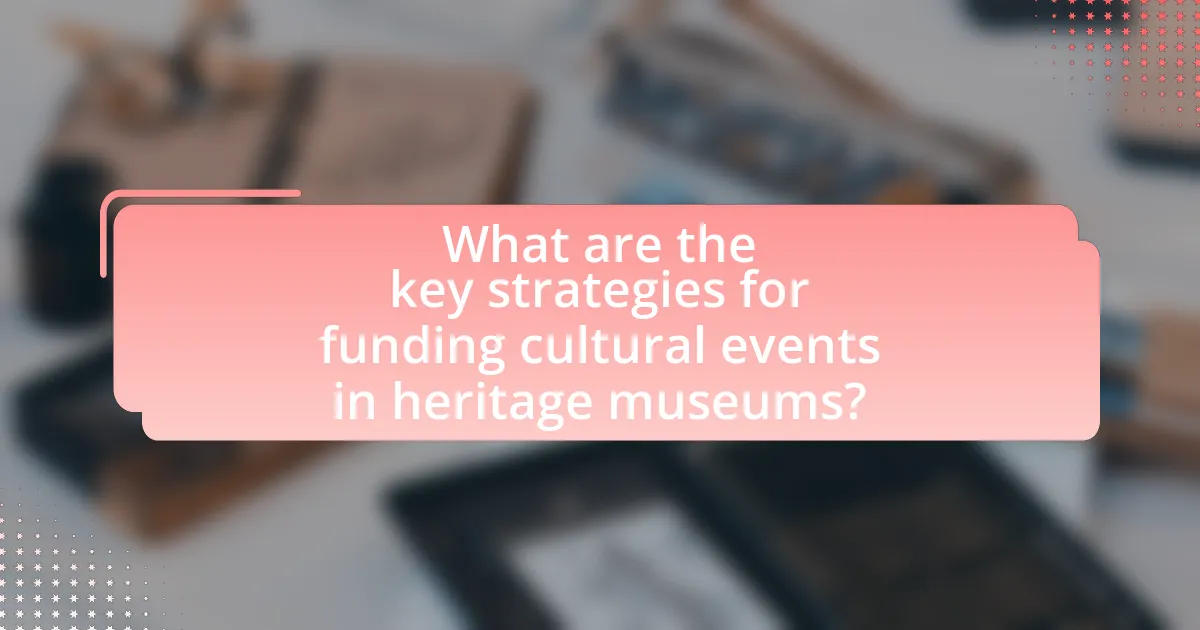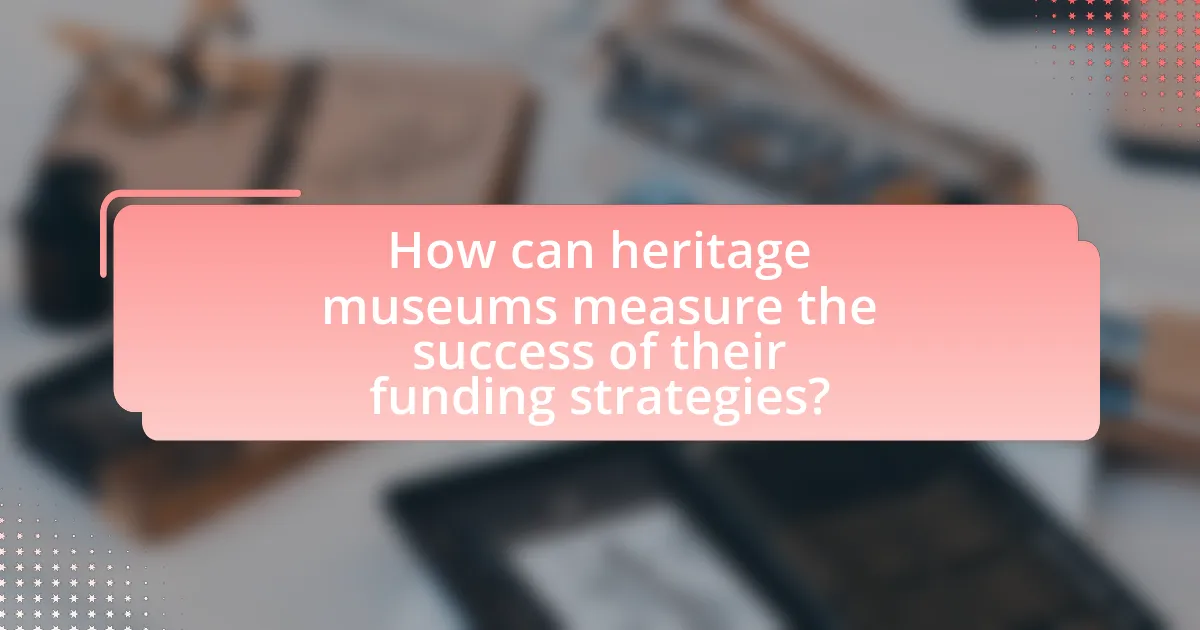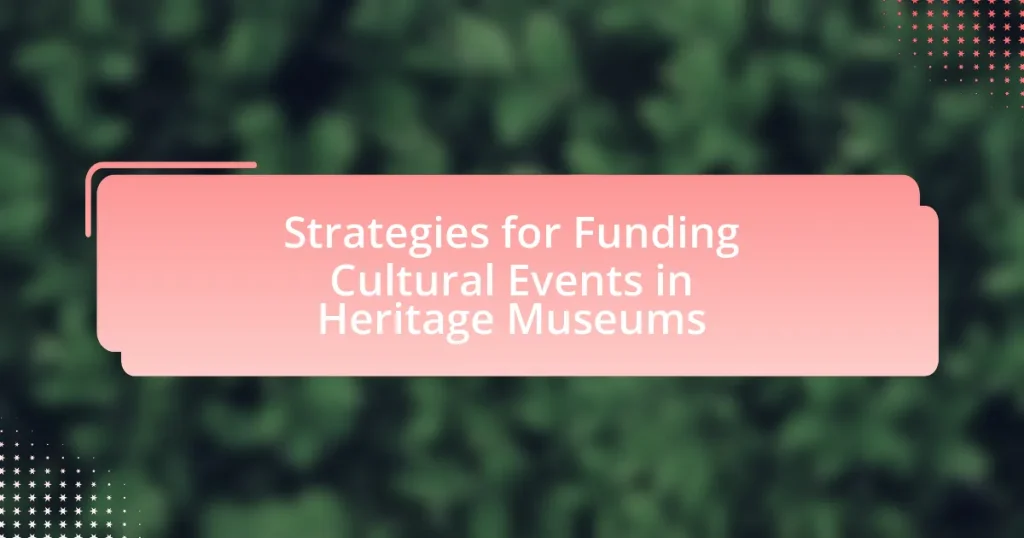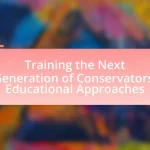The article focuses on strategies for funding cultural events in heritage museums, emphasizing the importance of diversifying revenue streams, establishing partnerships, and leveraging grants. It explores the impact of different funding sources on event scale and accessibility, highlighting the roles of government grants, private donations, and corporate sponsorships. Additionally, the article discusses the significance of community involvement, innovative fundraising techniques such as crowdfunding, and the challenges museums face in securing funding. It also addresses how economic factors and government policies influence funding availability, while providing best practices for enhancing funding strategy effectiveness.

What are the key strategies for funding cultural events in heritage museums?
Key strategies for funding cultural events in heritage museums include diversifying revenue streams, establishing partnerships, and leveraging grants. Diversifying revenue streams involves generating income through ticket sales, merchandise, and membership programs, which can provide a stable financial base. Establishing partnerships with local businesses and community organizations can enhance funding opportunities and increase visibility for events. Additionally, leveraging grants from government bodies, foundations, and cultural organizations can provide significant financial support; for instance, the National Endowment for the Arts offers grants specifically for cultural projects. These strategies collectively enhance the financial sustainability of cultural events in heritage museums.
How do different funding sources impact cultural events?
Different funding sources significantly impact cultural events by influencing their scale, accessibility, and sustainability. Public funding often allows for larger events that are free or low-cost to attendees, thereby increasing community participation and engagement. For example, government grants can support extensive programming and outreach initiatives, as seen in the National Endowment for the Arts, which allocated over $27 million in grants for arts projects in 2020. Conversely, private funding, such as sponsorships from corporations or donations from individuals, may lead to events that cater to specific audiences or themes, often prioritizing profitability and exclusivity. This can limit access for lower-income communities, as seen in events funded primarily through ticket sales or high-profile sponsorships. Additionally, reliance on diverse funding sources can enhance the resilience of cultural events, as demonstrated by the varied funding strategies employed by institutions like the Smithsonian, which combines federal support with private donations and earned income to sustain its programs.
What are the primary types of funding sources available for heritage museums?
The primary types of funding sources available for heritage museums include government grants, private donations, corporate sponsorships, membership fees, and fundraising events. Government grants, such as those from the National Endowment for the Arts, provide significant financial support for museum projects. Private donations from individuals or foundations often contribute to operational costs and special exhibitions. Corporate sponsorships can enhance visibility and provide financial backing for specific programs or events. Membership fees generate a steady income stream while engaging the community. Fundraising events, such as galas or auctions, not only raise funds but also foster community involvement and awareness of the museum’s mission.
How do grants and sponsorships differ in their application to cultural events?
Grants and sponsorships differ significantly in their application to cultural events, primarily in their funding sources and conditions. Grants are typically provided by government bodies, foundations, or non-profit organizations, and they often require a formal application process that includes detailed proposals and accountability measures. For instance, the National Endowment for the Arts offers grants that support specific cultural initiatives, requiring recipients to adhere to strict reporting guidelines. In contrast, sponsorships are usually provided by businesses or corporations seeking to promote their brand, and they often involve a mutually beneficial relationship where the sponsor receives advertising opportunities in exchange for financial support. For example, a local business might sponsor a cultural festival, gaining visibility through promotional materials and event signage. This distinction highlights that while grants focus on funding specific projects with accountability, sponsorships emphasize brand promotion and partnership.
Why is community involvement crucial for funding cultural events?
Community involvement is crucial for funding cultural events because it fosters local support and engagement, which are essential for securing financial resources. When community members actively participate in cultural events, they create a sense of ownership and pride, leading to increased attendance and donations. Research indicates that events with strong community backing often see higher funding levels; for instance, a study by the National Endowment for the Arts found that community-supported events can increase local sponsorship by up to 40%. This financial backing is vital for the sustainability and growth of cultural initiatives in heritage museums.
What role do local businesses play in supporting heritage museums?
Local businesses play a crucial role in supporting heritage museums by providing financial sponsorship, in-kind donations, and collaborative marketing efforts. These businesses often contribute funds that help cover operational costs, exhibit installations, and educational programs, which are essential for the museum’s sustainability. For instance, a study by the American Alliance of Museums found that local partnerships can increase visitor engagement and enhance community ties, demonstrating the mutual benefits of such collaborations. Additionally, local businesses may offer resources like materials or services, further enriching the museum’s offerings and outreach.
How can museums engage volunteers to enhance funding opportunities?
Museums can engage volunteers to enhance funding opportunities by creating structured volunteer programs that align with fundraising initiatives. These programs can involve volunteers in grant writing, event planning, and donor outreach, leveraging their skills and networks to attract financial support. For instance, a study by the National Endowment for the Arts found that organizations with active volunteer programs reported a 20% increase in funding compared to those without. By actively involving volunteers in these critical areas, museums can not only increase their funding but also foster a sense of community ownership and investment in the museum’s mission.
What innovative fundraising techniques can be employed?
Innovative fundraising techniques that can be employed include crowdfunding, experiential fundraising events, and leveraging social media campaigns. Crowdfunding platforms like Kickstarter and GoFundMe allow heritage museums to reach a wider audience and gather small contributions from many supporters, which can accumulate to significant amounts. Experiential fundraising events, such as immersive art installations or themed dinners, engage donors in unique ways, enhancing their connection to the museum and its mission. Social media campaigns can amplify outreach by utilizing platforms like Instagram and Facebook to share compelling stories and visuals, encouraging donations through direct links. These techniques have been shown to increase donor engagement and broaden funding sources, making them effective strategies for cultural events in heritage museums.
How can crowdfunding be effectively utilized for cultural events?
Crowdfunding can be effectively utilized for cultural events by leveraging community engagement and social media to attract diverse funding sources. Cultural organizations can create compelling campaigns that highlight the significance of their events, showcasing unique aspects such as local heritage, artistic contributions, and community benefits. For instance, successful crowdfunding campaigns often utilize platforms like Kickstarter or GoFundMe, where they can set specific funding goals and offer tiered rewards to backers, thus incentivizing contributions.
Research indicates that campaigns with clear narratives and visual storytelling tend to attract more backers; a study by the University of Pennsylvania found that projects with engaging videos raised 105% more funds than those without. Additionally, promoting the campaign through social media channels can amplify reach, as sharing among networks can lead to increased visibility and support. By fostering a sense of ownership and participation within the community, cultural events can not only secure necessary funding but also build lasting relationships with supporters.
What are the benefits of hosting fundraising events?
Hosting fundraising events provides essential financial support for cultural initiatives in heritage museums. These events generate revenue that can be allocated to preservation projects, educational programs, and community outreach efforts. For instance, a study by the National Endowment for the Arts found that organizations that host fundraising events can increase their funding by up to 30%, allowing them to enhance their offerings and engage more effectively with the public. Additionally, fundraising events foster community involvement and awareness, creating a platform for local stakeholders to connect with the museum’s mission and goals. This engagement can lead to increased membership and volunteer support, further strengthening the museum’s sustainability.

What challenges do heritage museums face in securing funding?
Heritage museums face significant challenges in securing funding, primarily due to competition for limited financial resources. Many heritage museums rely on government grants, which have been decreasing in recent years, leading to budget constraints. Additionally, private donations and sponsorships are often directed towards more prominent cultural institutions, leaving smaller heritage museums at a disadvantage. According to a report by the American Alliance of Museums, nearly 40% of museums reported a decline in funding during economic downturns, highlighting the vulnerability of heritage museums in fluctuating economic conditions. Furthermore, the lack of public awareness about the importance of heritage preservation can result in insufficient community support, further complicating funding efforts.
How do economic factors influence funding availability?
Economic factors significantly influence funding availability by determining the overall financial environment in which funding sources operate. For instance, during economic downturns, government budgets often shrink, leading to reduced grants and public funding for cultural events. Conversely, in a thriving economy, increased disposable income can lead to higher private donations and sponsorships for heritage museums. According to the National Endowment for the Arts, funding for arts and culture typically correlates with economic indicators such as GDP growth and unemployment rates, demonstrating that economic health directly impacts the resources available for cultural initiatives.
What impact does government policy have on museum funding?
Government policy significantly influences museum funding by determining the allocation of public resources and grants. For instance, policies that prioritize cultural heritage can lead to increased financial support for museums, as seen in countries like the United Kingdom, where the Arts Council England allocates funding based on government directives aimed at enhancing cultural access and preservation. Additionally, tax incentives for donations to museums can stimulate private funding, further enhancing financial stability. In contrast, austerity measures or budget cuts can severely limit operational budgets, leading to reduced programming and staffing. Thus, government policy directly shapes the financial landscape of museums, impacting their ability to serve the public and preserve cultural heritage.
How can museums adapt to changing economic conditions?
Museums can adapt to changing economic conditions by diversifying their funding sources and enhancing community engagement. By seeking alternative revenue streams such as grants, sponsorships, and partnerships with local businesses, museums can reduce reliance on traditional funding methods. For instance, the American Alliance of Museums reported that museums that actively pursued diverse funding options were better positioned to withstand economic downturns. Additionally, engaging the community through events, educational programs, and membership drives can foster a loyal visitor base, which is crucial during financial instability. This approach not only increases attendance but also encourages local support, as evidenced by the success of community-driven initiatives in various museums across the United States.
What are the common misconceptions about funding for cultural events?
Common misconceptions about funding for cultural events include the belief that funding is solely available from government sources and that all cultural events are inherently profitable. Many assume that only large organizations can secure funding, while in reality, smaller entities can also access grants and sponsorships. Additionally, there is a misconception that funding is only for traditional art forms, whereas diverse cultural expressions, including community-based projects, are often eligible for financial support. According to the National Endowment for the Arts, over 40% of grants are awarded to organizations with budgets under $500,000, demonstrating that smaller organizations can successfully obtain funding.
Why do some believe that funding is only available for large institutions?
Some believe that funding is only available for large institutions due to the perception that these organizations have greater resources, established networks, and a proven track record of successful projects. This belief is reinforced by the fact that many funding bodies, including government grants and private foundations, often prioritize applications from larger entities that can demonstrate significant impact and sustainability. For instance, a report by the National Endowment for the Arts indicates that larger institutions receive a disproportionate share of funding, which can create a cycle where smaller organizations struggle to compete for limited resources.
How can heritage museums overcome stigma associated with seeking funds?
Heritage museums can overcome the stigma associated with seeking funds by actively engaging with their communities and demonstrating the value of their cultural contributions. By hosting public events, educational programs, and outreach initiatives, museums can showcase their impact on local heritage and community identity, thereby fostering a sense of ownership and support among stakeholders. Research indicates that when museums effectively communicate their mission and the benefits of their programs, they can increase public willingness to contribute financially. For instance, a study by the American Alliance of Museums found that 78% of respondents believe that museums enhance community quality of life, which can translate into increased funding opportunities when museums highlight these benefits.
What strategies can mitigate funding challenges?
Diversifying funding sources is a key strategy to mitigate funding challenges for cultural events in heritage museums. By seeking grants from government agencies, private foundations, and corporate sponsorships, museums can create a more stable financial base. For instance, the National Endowment for the Arts reported that organizations receiving diverse funding are less vulnerable to economic fluctuations, as they are not reliant on a single source. Additionally, engaging in community partnerships can enhance funding opportunities, as collaborative projects often attract more attention and resources. This approach not only broadens the financial support but also fosters community involvement, which is crucial for the sustainability of cultural events.
How can museums diversify their funding streams?
Museums can diversify their funding streams by implementing a mix of strategies such as developing membership programs, hosting special events, and pursuing grants from various sources. Membership programs can create a steady income stream, as evidenced by the American Alliance of Museums reporting that membership fees contribute significantly to operational budgets. Special events, including exhibitions and workshops, can attract diverse audiences and generate additional revenue. Furthermore, museums can seek grants from government bodies, private foundations, and corporate sponsors, which have been shown to provide substantial financial support; for instance, the National Endowment for the Arts awarded over $27 million in grants to arts organizations in 2020. By combining these approaches, museums can enhance their financial stability and reduce reliance on a single funding source.
What partnerships can be formed to enhance funding opportunities?
Collaborations with local businesses, educational institutions, and government agencies can enhance funding opportunities for cultural events in heritage museums. Local businesses can provide sponsorships or in-kind donations, while educational institutions can facilitate grants and joint programs that attract funding. Government agencies often have specific funding programs aimed at cultural preservation and community engagement, which can be accessed through partnerships. For instance, the National Endowment for the Arts offers grants that can be leveraged through collaborations with non-profit organizations and educational entities, demonstrating the effectiveness of strategic partnerships in securing financial support for cultural initiatives.

How can heritage museums measure the success of their funding strategies?
Heritage museums can measure the success of their funding strategies through key performance indicators (KPIs) such as visitor attendance, revenue generated from ticket sales, and the number of successful grant applications. For instance, a museum that tracks an increase in visitor numbers after implementing a new funding strategy can directly correlate that success to the effectiveness of its funding efforts. Additionally, analyzing the percentage of funding obtained through grants versus donations can provide insights into which funding sources are most effective. Research indicates that museums that actively engage with their communities and tailor their funding strategies to local interests often see a 20-30% increase in both attendance and funding success, demonstrating the impact of targeted approaches.
What metrics are useful for evaluating funding effectiveness?
Metrics useful for evaluating funding effectiveness include return on investment (ROI), audience engagement levels, and program sustainability. ROI measures the financial return relative to the funding amount, providing a clear indication of financial effectiveness. Audience engagement levels, assessed through attendance figures, participant feedback, and social media interactions, reflect the impact of funding on community involvement and interest. Program sustainability evaluates whether funded initiatives can continue without ongoing financial support, indicating long-term effectiveness. These metrics collectively provide a comprehensive view of how effectively funding is utilized in cultural events at heritage museums.
How can visitor engagement be linked to funding success?
Visitor engagement is directly linked to funding success as higher engagement levels often lead to increased donations and sponsorships. Engaged visitors are more likely to contribute financially, as they develop a personal connection to the museum and its mission. For instance, a study by the American Alliance of Museums found that museums with interactive exhibits and community involvement saw a 30% increase in funding compared to those with less visitor interaction. This correlation highlights that fostering a vibrant visitor experience not only enhances attendance but also boosts financial support, making engagement a critical factor in securing funding for cultural events in heritage museums.
What financial indicators should museums track over time?
Museums should track revenue, expenses, net income, and visitor attendance over time. Revenue includes ticket sales, membership fees, and donations, which provide insight into financial health and funding sources. Expenses encompass operational costs, program expenditures, and maintenance, helping museums manage budgets effectively. Net income, calculated as revenue minus expenses, indicates overall profitability and sustainability. Visitor attendance serves as a key performance indicator, correlating with revenue trends and community engagement. Tracking these indicators allows museums to make informed financial decisions and adapt strategies for funding cultural events.
How can feedback from stakeholders inform funding strategies?
Feedback from stakeholders can significantly inform funding strategies by providing insights into community needs and preferences. Stakeholders, including visitors, local businesses, and cultural organizations, can share their perspectives on what types of events would attract more attendees and enhance community engagement. For instance, a survey conducted by the American Alliance of Museums found that 75% of museum visitors prefer events that reflect local culture and history, indicating that aligning funding with stakeholder feedback can lead to more successful programming. By analyzing this feedback, heritage museums can prioritize funding for events that resonate with their audience, ultimately increasing attendance and financial support.
What methods can be used to gather community feedback on events?
Surveys and questionnaires are effective methods to gather community feedback on events. These tools can be distributed both online and offline, allowing participants to provide their opinions and suggestions regarding various aspects of the event, such as content, organization, and overall experience. Research indicates that structured surveys can yield quantitative data that is easy to analyze, while open-ended questions can provide qualitative insights. For instance, a study by the National Endowment for the Arts found that 70% of cultural organizations that utilized surveys reported improved programming based on community feedback.
How can museums use surveys to assess funding impact?
Museums can use surveys to assess funding impact by collecting quantitative and qualitative data from visitors and stakeholders regarding their experiences and perceptions of funded programs. This approach allows museums to evaluate the effectiveness of funding by measuring visitor satisfaction, engagement levels, and educational outcomes related to specific exhibits or events. For instance, a survey might include questions about how funding improved accessibility or enhanced programming, providing concrete feedback that can be analyzed to determine the return on investment. Additionally, data from surveys can be compared against attendance figures and revenue generated from events, offering a comprehensive view of funding effectiveness.
What best practices can enhance funding strategy effectiveness?
To enhance funding strategy effectiveness for cultural events in heritage museums, organizations should prioritize building strong relationships with potential funders. Establishing trust and open communication with donors, sponsors, and grant-making bodies increases the likelihood of securing financial support. Research indicates that organizations with robust donor engagement strategies experience a 20% increase in funding success rates, as highlighted in the 2021 report by the National Endowment for the Arts. Additionally, diversifying funding sources—such as combining grants, sponsorships, and individual donations—can mitigate risks associated with reliance on a single funding stream, thereby improving overall financial stability.
How can museums create a compelling case for support?
Museums can create a compelling case for support by clearly articulating their mission, demonstrating community impact, and showcasing the value of their programs. By presenting specific data, such as visitor statistics and educational outreach numbers, museums can illustrate their role in cultural preservation and community engagement. For instance, a study by the American Alliance of Museums found that museums contribute over $2 billion annually to local economies, highlighting their economic significance. Additionally, sharing success stories and testimonials from visitors can further strengthen the emotional appeal, making a persuasive argument for funding and support.
What role does storytelling play in attracting funding for cultural events?
Storytelling plays a crucial role in attracting funding for cultural events by creating an emotional connection between potential donors and the event’s mission. This connection enhances the perceived value of the event, making it more appealing to funders. For instance, a study by the National Endowment for the Arts found that narratives highlighting community impact and personal stories significantly increase donor engagement and willingness to contribute. By effectively communicating the significance and impact of cultural events through storytelling, organizers can demonstrate the relevance of their initiatives, thereby increasing the likelihood of securing financial support.


